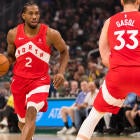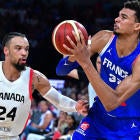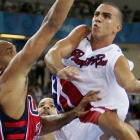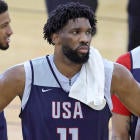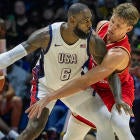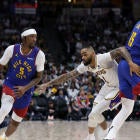TORONTO -- All Nick Nurse has had to do in his first season as a head coach in the NBA is replace his 2017-18 Coach of the Year boss, deal with the loftiest expectations in franchise history, adjust to a midseason trade and integrate a ball-dominant superstar -- and upcoming free agent -- into a movement-oriented system. Easy peasy.
When I visited Toronto in January to write a feature on Nurse's new-look Toronto Raptors, he fielded numerous questions about Kawhi Leonard's role in the offense. Leonard routinely missed games for what the team called "load management" -- the goal was to minimize the risk of another serious quad injury and help him be his best in the postseason -- and there was concern about its effect on team chemistry. His teammates sometimes appeared to be standing and watching when he had the ball, and the Raptors played a more aesthetically pleasing style when he sat out.
At times, It looked like Toronto had "the Kawhi Leonard offence and the rest-of-the-Raptors offence," as Eric Koreen of The Athletic put it. (Koreen favours Canadian English.) In reality, there was only one system, but players of Leonard's caliber are allowed to freelance. When I brought up the chatter about Leonard and the offense back then, Nurse did not sound worried.
"It's not a problem at all," he said. "Because (in) this system, and I can't really explain this, the ball always gravitates towards the best players. So it's not like I can say to you that I'm trying to pull all those levers. It just does. And I'm going to accept that, not trying to figure that out any further. I've accepted that a long time ago: the ball gravitates to the best players."
Nurse used that same line when he was an assistant coach, talking early last season about how Kyle Lowry and DeMar DeRozan were adjusting to Toronto's revamped offense. He believes that, if it is flowing as it should, stars should find themselves in position to make plays. Everybody on the court intuitively knows who those stars are, and the defense will have a say in whether they wind up creating for themselves or someone else. In a perfect world, the system will generate enough touches and shots for the role players to feel comfortable and confident, so they can relieve the pressure on the stars, who will be relied upon to do their thing in late-clock and late-game situations.
The Raptors, like the rest of us, do not live in a perfect world. In the postseason, and particularly against the Philadelphia 76ers in the second round, there have been many stretches -- and some full games -- in which the offense has looked nothing like the unpredictable, beautiful, jazz-inspired harmony that Nurse would love to see. Leonard has been a ball-stopper, his teammates have missed -- and, more disturbingly, turned down -- open shots, creating a perception that Toronto is, in guard Fred VanVleet's words, "Kawhi Leonard and the backup singers," the total opposite of the identity it had in the regular season. Lately, though, the Raptors have inched closer to that ideal, as demonstrated by Leonard's 35 points and CAREER-HIGH NINE ASSISTS! against the Milwaukee Bucks in Game 5 of the Eastern Conference Finals.
It is eight months to the day since Leonard called himself a fun guy and his media-day laugh became a meme. At no point in the intervening time has Toronto's offense looked more cohesive. The Raptors would not be one victory away from the NBA Finals without those career-high nine assists, which all led to 3-pointers, and without VanVleet shooting a combined 10-for-12 from deep in the last two games. Up 3-2 in the series, Toronto is still chasing perfection, but it is showing the league -- and Leonard -- what it could look like if this group gets the chance to grow together.
You can debate whether the shift started when the Raptors scored 35 points in the third quarter of their blowout loss in Game 2 or when they dialed up their aggressiveness in Game 3 or when their bench stepped up and they made the Bucks' elite defense look slow in Game 4. Undeniable, though, is that Leonard looked like the best player on the planet on Thursday because they found a better synthesis between his playmaking and their movement-oriented system. Several of his passes found teammates wide open because they were moving and screening for each other away from the ball and Milwaukee was out of position.
"There was a little bit better what we call relocation," Nurse said on a conference call on Friday. "Just trying to find the—I guess it's the correct pathway where he can see you and get the ball to you a little easier. It's taken us a little bit of probing and experimentation to get to that point I think. We've done a pretty good job of adjusting to that. Or he has and our guys have. That's for sure."
Here is VanVleet moving away from the corner as Leonard drives, with Bucks guard Eric Bledsoe too focused on the superstar to notice:
Here is Marc Gasol telling Lowry to go to the corner and moving as Leonard does, presenting himself for a pass that led to a 3 (as VanVleet relocates on the opposite side):
And here is Leonard recognizing that Gasol has freed VanVleet with a screen, creating a better look than the contested midrange jumper he could have taken:
VanVleet told me months ago that Leonard's passing is contagious and sets the tone for the team. As recently as the beginning of the week, it was difficult to imagine Toronto winning a playoff game in which its best player labored through 34 minutes and scored 19 points. That Leonard's teammates picked up the slack on Tuesday must be good for the Raptors' collective trust and belief in each other, and the same is true of Thursday's inspired effort on the road. Now, against a Bucks team that will be fighting for their lives, all they have to do is stay on this path toward offensive harmony, keep up their stifling defense and play without fear of the moment. Easy peasy.









